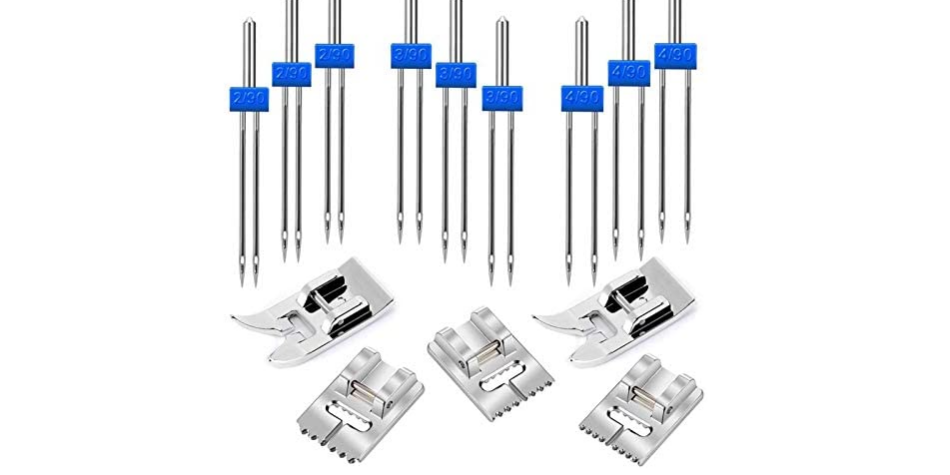In this sewing tutorial, I want to show you how to use a twin needle – a very simple tool that expands the capabilities of even the most ordinary sewing machine.
The twin needle is made of two needles that are attached to a single crossbar.
It produces two rows of stitching on the topside and a zigzag stitch (well, kind of) on the back. It’s often used for hemming garments made from knit fabric – the stitch looks similar to the hem stitch on a T-shirt.

So, if you don’t have a special sewing machine to sew this kind of hems (it’s called a cover stitch machine) you can use the twin/double needles on your regular home sewing machine if you want professionally finished hems on knit garments.
The only big problem is that the seam doesn’t tolerate stretching very well.
Twin needles are often used for decorative stitching.
With the twin needle, you can stitch two rows simultaneously creating various decorative effects. They have different distances between the individual needles, and depending on this distance, the appearance of the decorative stitch will change (becoming narrower or wider). A different width between the needles makes it possible to choose the width of the finishing stitch. Therefore, you will probably need to have several types of twin needles.

Types of twin/double needles
Different types of double needles are designed to work with different materials.
The needles differ by dimensions (thickness of the needle and the distance between the needles); by the color of the crossbar – the most common are dark blue and red but I saw also white light blue, and yellow; by the needle tip shape; by the size of the needle eye.
The most well-known and popular twin needles among consumers are manufactured by Schmetz, Singer, Klasse, and Organ.
UNIVERSAL TWIN NEEDLES
Universal twin needles are great general-purpose needles. They are used for most woven fabrics and some stable knits. The universal needle has a slightly rounded tip so that it slips through the weave of knits easily while still retaining enough sharpness for woven fabrics.
STRETCH TWIN NEEDLES
Twin needles for stretchy knit fabric are usually thinner (size 75) and produced in two types: with an inter-needle distance of 2.5 or 4mm.

Compared with the same size universal twin needle, the stretch twin needle has a more rounded tip called also a “ballpoint”. With a round tip, the stretch twin needle does not pierce the material, but spreads the fibers to the sides and penetrates the fabric’s surface without tearing its fibers.
EMBROIDERY TWIN NEEDLE
Embroidery twin needles are distinguished by an enlarged groove and eye, which makes them perfect for decorative stitches.

Embroidery is usually done at a higher speed than regular sewing. Specially coated, the larger eye allows smooth thread flow at higher speeds. This type of twin needles can be used with different embroidery threads – rayon, polyester, and cotton.

METALLIC TWIN NEEDLES
Metallic twin needles differ from the rest because of their enlarged specially coated eye (2 mm) and a large groove in a shaft that prevents thread breaks.
DENIM TWIN NEEDLES
A twin needle for denim, in comparison to a double universal needle, has a sharp, strong point that penetrates dense fabrics.

Naturally, such a tip penetrates into multiple layers of thick material faster. In addition, the size of a twin needle for use on jeans is 100. Such a thick and sharp needle will make stitching denim fabric easy. Also ideal for topstitching woven fabrics.
TWIN NEEDLE SIZES
Double needles are most often made in the following sizes: 1.6 mm, 2, 2.5, 3, 4. There are also double needles with a particularly large distance between the needles – 6 and 8 mm.
Like a regular needle, the size of a double needle is also determined by the thickness of the shaft. The thinnest double needles for knit fabrics are numbered 75. The number 80 is usually for sewing with metallic thread. No. 80, 90, and 100 are universal or embroidery needles. Denim needles have a size of 100.
When you look at the pack of twin needles you usually see two numbers in the size of the needle. The two numbers indicate the space between the tips and the size of the needles, respectively. For instance, a size 80/4.0mm needle is two sizes 80 needles spaced 4 mm apart. And a size 75/2.0mm needle is two sizes 75 needles spaced 2 mm apart.
How to install a twin/double needle
The twin needle is easily installed on most models of sewing machines.
Turn the handwheel to put the needle in its highest position. Lower the presser foot or even take the presser foot out. After that, hold the regular needle (if it’s there), weaken the fixing screw, and remove the needle from the needle holder. Turn the twin needle with the flat side away from you and insert it in place of the previous one until the needle touches the stopper. Holding the needle with your hand, tighten the fixing screw.
For sewing with a twin needle, two spools of thread are needed. To get a neat and even stitch, the threads on both spools should be the same in terms of quality and thickness. The color, however, may be different. In addition, the threads from both spools should “exit” at the same speed preferably. To ensure such synchronization, it may be necessary to wind the threads on two identical bobbins so that they both fit on the same pin for the spool of thread. But of course, there are other ways to thread twin needles



